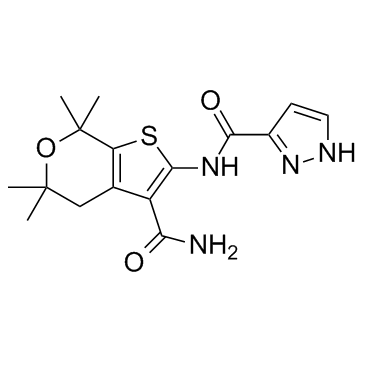| Description |
GLPG1837 is a potent and reversible CFTR potentiator, with EC50s of 3 nM and 339 nM for F508del and G551D CFTR, respectively.
|
| Related Catalog |
|
| Target |
EC50: 3 nM (F508del CFTR), 339 nM (G551D CFTR)[1]
|
| In Vitro |
GLPG1837 is a potent CFTR potentiator, with EC50s of 3 nM and 339 nM for F508del and G551D CFTR, respectively. GLPG1837 increases the conductivity of the G551D CFTR channel with obtained potency of 181 nM[1]. GLPG1837 is reversible CFTR potentiator, with a the apparent affinity within a range of 0.2∼2 µM[2].
|
| Cell Assay |
CFBe41o- cells are cultured in Eagle’s Minimal Essential Medium (MEM) supplemented with 10% fetal bovine serum (FBS), 1% penicillin/streptomycin, 1% l-glutamine, and 500 μg/mL hygromycin B. The cells are grown on culture flasks coated with 0.01% bovine serum albumin (BSA), 30 μg/mL Purecol, and 0.001% human fibronectin. CFBe41o- cells are transduced with adenoviruses containing F508del CFTR and YFP (H148Q/I152L/F47L). HEK293 cells are cultured in Dulbecco’s Modified Eagle Medium (DMEM) supplemented with 10% FBS and 1% penicillin/streptomycin. HEK293 cells are transfected with plasmids containing G551D, G178R, S549N, R117H, CFTR, and YFP (H148Q/I152L/F47L). Directly after transfection, the HEK293 cells are seeded in black 96-well plates coated with poly-d-lysine at a density of 70000 cells per well. The next day, cells are incubated for 24 h at 27°C (CFBE41o−) or 37°C (HEK293). Then cells are treated for 10 min with 10 μM forskolin and the desired concentration of potentiator at room temperature.
|
| References |
[1]. Van der Plas SE, et al. Discovery of N-(3-Carbamoyl-5,5,7,7-tetramethyl-5,7-dihydro-4H-thieno[2,3-c]pyran-2-yl)-lH-pyrazole-5-carboxamide (GLPG1837), a Novel Potentiator Which Can Open Class III Mutant Cystic Fibrosis Transmembrane Conductance Regulator (CFTR) Channels to a High Extent. J Med Chem. 2018 Feb 22;61(4):1425-1435. [2]. Yeh HI, et al. A common mechanism for CFTR potentiators. J Gen Physiol. 2017 Dec 4;149(12):1105-1118.
|
